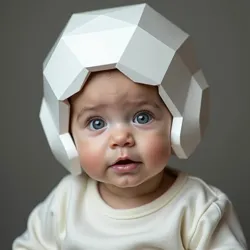Cephalomorphic Infant Customization
 A 6-month-old infant wearing a dodecahedral shaping helmet designed by Geobaby Solutions
A 6-month-old infant wearing a dodecahedral shaping helmet designed by Geobaby SolutionsCephalomorphic Infant Customization (CIC) represents a controversial yet growing trend in elective pediatric modification, where parents opt to alter their infant's natural cranial development through the use of specialized geometric helmets and shaping devices. This practice, which emerged in the mid-2030s, has sparked intense debate within medical, ethical, and cultural spheres while garnering a dedicated following among certain social groups and futurist communities.
Historical Development
The origins of geometric head shaping can be traced to the convergence of traditional cranial molding practices and advanced 3D printing technologies. While cultures throughout history have practiced various forms of head shaping, modern geometric modification emerged from the work of Dr. Helena Voss, who initially developed precise cranial orthoses for treating plagiocephaly. Her research into controlled cranial development led to the creation of the first recreational shaping helmets in 2034.
The practice gained significant momentum following the viral success of the "CubeBaby" social media phenomenon, where influential parents began sharing images of their infants with distinctly geometric cranial features. This trend coincided with the rise of neo-architectural body modification movements and the increasing acceptance of early-life aesthetic alterations.
Technical Process
Modern cephalomorphic modification utilizes a combination of gentle, sustained pressure and guided growth patterns to achieve desired geometric forms. The process typically begins between 4 and 8 months of age, when an infant's cranial bones remain malleable. Parents can choose from a wide array of geometric configurations, with the most popular shapes including:
- Cubic (marketed as "CubeCranial")
- Pyramidal (known as "PyramidPlex")
- Rhomboidal (branded as "RhomboShape")
- Dodecahedral (called "DodecaForm")
The helmets themselves incorporate smart pressure sensors and adjustable panels that gradually guide cranial development according to computer-modeled growth patterns. Treatment duration typically ranges from 6 to 14 months, depending on the complexity of the desired shape and the individual infant's development rate.
Medical Considerations
 Anatomical diagram showing the progressive geometric modification process over 8 months
Anatomical diagram showing the progressive geometric modification process over 8 monthsThe medical community remains divided on the safety and ethical implications of geometric head shaping. Proponents, led by researchers at the Institute for Pediatric Morphological Innovation, argue that controlled cranial modification during infancy poses no significant risks when properly monitored. They cite extensive studies showing normal cognitive development in children who have undergone geometric shaping.
However, critics, including the Association for Natural Pediatric Development, express concerns about potential long-term effects on brain development, cerebrospinal fluid dynamics, and facial growth. Some medical professionals have reported cases of Geometric Pressure Syndrome (GPS), a condition characterized by temporary sensory sensitivity and mild motor coordination challenges.
Societal Impact and Controversy
The rise of geometric head shaping has led to significant social discourse regarding body modification, parental rights, and the nature of human enhancement. Advocates of the practice often align with transhumanist philosophy and argue that geometric modification represents a natural evolution in human aesthetic expression. They point to the success of numerous adults who underwent the procedure as infants and now hold prominent positions in various fields.
Critics, however, raise ethical concerns about performing elective geometric modifications on non-consenting infants. The debate has led to the formation of advocacy groups such as Natural Head Rights and Freedom of Form, which lobby for and against regulation of the practice, respectively.
Cultural Significance
Geometric head shaping has spawned its own subculture, complete with specialized fashion lines, educational institutions, and social networks. The Geometric Generation movement celebrates modified cranial features as expressions of human creativity and technological progress. Annual events like the Global Geometric Gathering showcase new shaping techniques and celebrate successful modifications.
The practice has also influenced contemporary architecture, fashion, and design, with numerous creators drawing inspiration from modified cranial geometries. The Neo-Geometric Design Movement explicitly references infant head shaping in its manifestos and works.
Legal Framework
Different jurisdictions have adopted varying approaches to regulating geometric head shaping. While some regions have embraced the practice with minimal oversight, others have implemented strict guidelines or outright bans. The International Coalition for Morphological Rights continues to advocate for standardized global regulations while protecting parents' rights to pursue geometric modification.
Notable legislation includes the Cranial Choice Act in several progressive regions, which establishes safety standards and practitioner certification requirements while affirming parents' rights to pursue geometric modification. More conservative jurisdictions have enacted Natural Development Laws that restrict or prohibit elective cranial modification.
Future Developments
Research continues into advanced shaping techniques and new geometric possibilities. The development of dynamic morphological matrices promises to enable more complex and precise modifications, while innovations in materials science may reduce treatment duration and improve comfort. Some researchers are exploring the potential for reversible modification techniques that would allow individuals to alter their cranial geometry throughout life.
The field of cephalomorphic customization continues to evolve, with ongoing debates about its role in human enhancement and child development. As technology advances and societal attitudes shift, the practice remains a fascinating intersection of medical innovation, ethical consideration, and cultural expression.
Scientific Research
Current research focuses on understanding the long-term implications of geometric modification and developing improved techniques. The Center for Morphological Studies conducts longitudinal studies of modified individuals, while biotechnology firms explore new materials and methods for achieving more precise results with shorter treatment times.
Recent breakthrough studies in cranial plasticity have revealed previously unknown aspects of skull development, leading to refinements in shaping techniques and improved safety protocols. These advances have helped address some medical concerns while opening new possibilities for geometric complexity.
The field continues to generate significant academic interest, with numerous universities establishing dedicated research programs and peer-reviewed journals focusing on morphological modification studies.